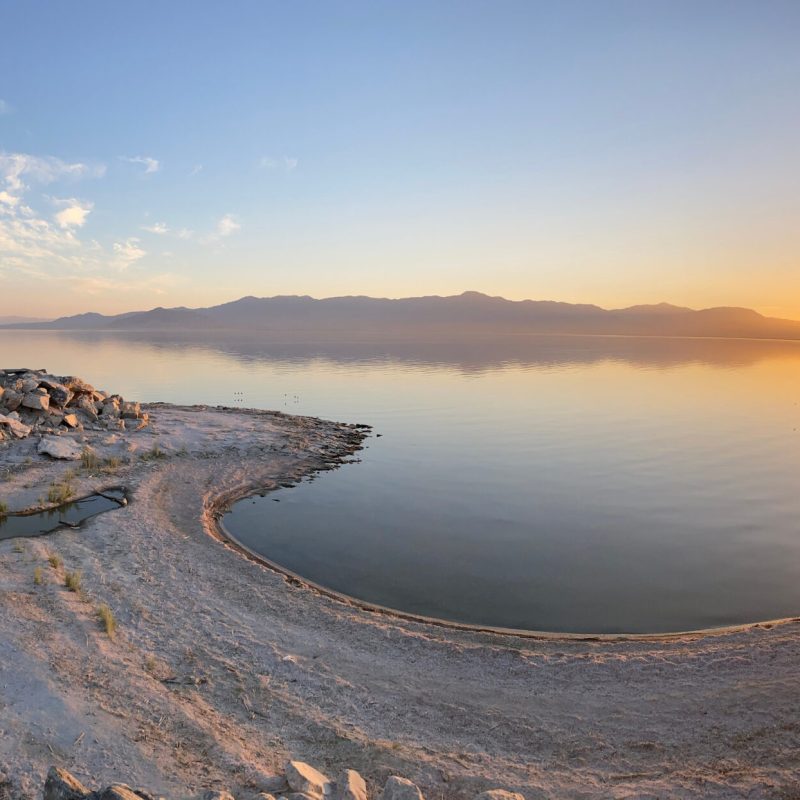
You may actually smell the Salton Sea before you see it. A briny, slightly fishy smell that’s more earthy than unpleasant wafts away from its salty shores, beckoning visitors to look — but not touch. Settled into one of the lowest places on earth, the waters of the sea stretch from its desert shores, reflecting the rugged mountains that surround it. This accidental expanse of blue lies less than an hour’s drive from Palm Springs and tells a tale of boom and bust in the California desert.
Videos by TravelAwaits
A Sea Is Born
The current sea is young by geological measures — very young. It formed after floods breached a Colorado River-fed canal in 1905 and began to fill a low spot between the Coachella and Imperial valleys formerly known as the Salton Sink. Rather than quickly evaporating in the desert’s 100+ degree heat, the sea stayed put thanks to agricultural irrigation runoff near its shores.
Ancient lakes formed here before, but this modern occurrence gave rise to speculators’ dreams. Spotting a chance to build a resort paradise within driving distance of Southern California, developers built hotels, restaurants, bars, and communities along its shores. The area thrived in the ‘50s and ‘60s, but the very runoff that kept the lake filled eventually brought its demise. The chemicals from farming poisoned the water, driving off wildlife, visitors, and residents alike. In recent years, attempts to limit runoff coupled with climate change have led to the sea shrinking at an increasing rate, leaving once beachfront homes hundreds of yards from the water.
The state and federal governments have looked at various approaches to save the sea. At publish time, there is a $20 million effort to restore wildlife habitats. While we wait to see if these efforts will bear fruit, there are still places for travelers to visit to see the beauty and desolation of this area.
Things To Do At The Salton Sea
Bustling no more, the Salton Sea still hosts serene and captivating recreation — especially along the sea’s North Shore. Go hiking, fishing, birding, and more in one at one of the most unusual bodies of water you’ll ever visit.
Make The Most Of Public Campgrounds
A great place to start a visit to the area is the Salton Sea State Recreation Area. This attraction is actually a series of beaches, campgrounds, and hiking areas running from the northern tip of the lake and along its eastern side, an area known as the North Shore. Driving to the area from Palm Springs takes about an hour along Interstate 10 and California 111.

In the town of Mecca, travelers can see the free visitors center to learn more about the sea, its wildlife, and efforts to save it. A special treat there is the collection of memorabilia from the sea’s heyday as a tourist draw. Rangers in the center can also give tips for birdwatching and catching glimpses of the sea’s other wildlife. The center is at 100-225 State Park Road in Mecca, just off California 111. It’s open 9 a.m. to 4 p.m. Wednesday through Sunday, closed on Mondays and Tuesdays.
The park offers camping at four campgrounds nestled into the shore of the sea. All offer spectacular mountain views across the sea and are great spots from which to watch the sunset. Once night falls, the lack of nearby development means the sky can prove to be very impressive on clear nights. Some of the campsites here are primitive, meaning no bathrooms or other facilities. Campers wishing for some of those amenities can find them at the more developed camps, such as the New Camp Campground and the Mecca Beach Campground at the north end of the park. The state takes reservations for the campsites through its ReserveCalifornia website. Overnight campsites typically run from $20 to $30. The campgrounds are small, but demand is not normally high for the area. Still, it pays to plan in advance and book your campsites as early as possible.
One note of warning: Campers report large numbers of flies and mosquitoes in the area, so it will be a good idea to pack along some insect repellent.
Enjoy The Beaches, But Stay Dry
Throughout the park, access to the beach is easy. Visitors will find rocky, sandy, and shell-strewn beaches that offer a place to catch some sun or explore the terrain. Be aware that the toxic nature of the water means no swimming is permitted in the sea, though small boats that can be hand-carried to the water are allowed. The toxic waters also deposit dead fish on the beaches. The smell can be intense at times, but this is not a year-round issue. In fact, though it may seem the fish carcasses found on the beaches have just washed up, the preservative properties of the salty water mean many of them have been there for years. Fishing is allowed at the sea, but the state suggests (PDF) severely limiting consumption of your catches. Just to be safe, most wise anglers practice catch and release when fishing the sea.
Take A Higher Hike To Enjoy The View
Hiking in the area of the Salton Sea State Recreation Area is generally limited to shoreside walks. But adventurous hikers who want to see more of the terrain may want to make the climb up Bat Caves Butte Trail, with its trailhead just south of the recreation area.

Parking for the trail lies just off California 111 at Crooker Drive. Cross the highway to find the start of the 3-mile trail loop heading up about 300 feet from the seashore to about 85 feet above sea level. Along the climb, you’ll find seashells and other evidence of larger bodies of water that once covered the area. Views are striking looking back west across the sea and at the mountains to the north that divide the Coachella Valley from Joshua Tree National Park. Once at the top, you’ll find the caves formed by pressure on the San Andreas Fault pushing the layers of rock upward, with the softer parts dissolving away over time.
Enter Birder Paradise
Back down at the seashore, continue south on California 111 along the east side of the lake to find the Sonny Bono Salton Sea National Wildlife Refuge at its south end. Named for the entertainer and congressman who was a champion for saving the sea — and who started his political career as mayor of nearby Palm Springs — the refuge boasts an abundance of birds due to its location on the Pacific Flyway.

The Audubon Society considers the sea to be one of the most important areas for birds in North America, designating it an IBA, or Important Bird Area. It serves as a significant place for birds to nest and spend the winter. The Audubon Society estimates millions of birds representing about 400 species call the sea home.
Visiting the refuge is easy if travelers continue south on California 111 from the North Shore area, stopping at its free visitors center at 906 W. Sinclair Road in Calipatria. The center is open weekdays from 7 am to 3:30 p.m. and weekends from 8 a.m. to 4:15 p.m. The center offers information, maps, and displays about the wildlife in the area. Hikers can then set out on the two-mile Rock Hill Trail which runs from the visitors center to a rocky hill overlooking the sea.
The main draw of the refuge is the chance to see the many species of birds present there. Birders will also enjoy a trip to the southern tip of the sea to visit the other trail in the refuge, the Michael Hardenberger Trail. Head south on California 111 from the visitors center, turning west on California 78 in Hovley. Follow the highway west about 15 miles to Vendel Road, turning right to head north to the trailhead. The trail is a short, half-mile loop surrounding a freshwater pond, home to migratory and nesting birds. It goes without saying that a good pair of binoculars will be your best friend when visiting any of the wildlife areas.
See What’s Left Of What Might Have Been
Visitors who want to complete a circumnavigation of the sea should return to the Palm Springs area via California 86 along the west shore. Worth a short stopover are the towns of Salton Sea Beach and Desert Shores. Driving through these developments, visitors can see the devastation the receding sea waters have left behind. Homes built on canals that once housed ski boats and other watercraft now sit dilapidated on dry ditches. Residents remain in this area, living in the shadow of the promise it once held as a vacation paradise a short drive from Los Angeles.

One last word of advice for any visit to the Salton Sea or the surrounding desert. Bring plenty of water! The dry, salty, and sunny conditions mean your body will dehydrate rapidly with just the smallest bit of exertion. The National Park Service recommends carrying enough water to replenish what you lose during hot weather hikes — as much as 2 liters per hour! Keep hikes short enough, build in plenty of rest time, and drink, drink, drink that water.
